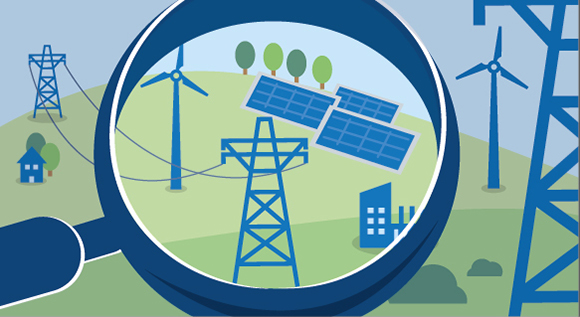What exactly is the ‘energy union’?
A common electricity and gas market that stretches from Portugal to Finland. It is designed to provide consumers with affordable and clean energy. For more information about what this EU project entails, please click here.
 © BMWi
© BMWiThe aim: to bundle energy within Europe
When there’s not much wind blowing in Germany, the level of electricity that wind power plants feed into the German grid falls. However, if – at the same time – high winds are sweeping across Spain, Southern Europeans suddenly have more wind power they actually need. This will lead Spain to reduce generation capacity, while Germany has to raise production in conventional power plants, leading to higher greenhouse gas emissions. This is like a farmer who throws away his eggs because he can’t find anyone to buy them, while his neighbour – who has no hens of his own – goes to the supermarket to buy eggs there. It would clearly be in the best interests of both neighbours if they were to cooperate with each other.
Consumers benefit from clean energy at affordable prices
The Energy Union is the political framework in which energy cooperation can take place between the Member States of the EU. One of the aims is to drive forward the internal market for electricity and gas. When energy flows from one country to another unhindered, energy costs are reduced right across Europe. This is because the costs of reducing generation while there is an energy surplus or of keeping reserve power plants ready disappear. As a result, consumers then benefit from lower energy costs.
The Energy Union is, however, about much more than just developing a common market for electricity and gas. It is about ensuring that the supply of energy remains secure and affordable for all Europeans as we move into the future. This is crucial in order for us to maintain our standard of living – in order for Europe to continue to grow and create new jobs. To meet its joint climate targets, Europe needs to switch to using renewable, low-emission energy. After all, the energy transition will only be successful if we adopt a joint European approach – i.e. if all Member States get involved and start to shape this transition. This is similar to the neighbour who, by cooperating with the farmer on eggs, would stand to benefit also.
The five fields of action for the Energy Union
What are the exact aims of the Energy Union? The European Commission has developed an overall strategy for the Energy Union comprising five fields of action which are closely interlinked:
- Ensuring security of supply: Supply security for gas and electricity to the general population is to be ensured, and dependency of the EU on energy imports reduced.
- Establishing an internal energy market: Energy is to flow freely between the different countries of the EU – through the establishment of the relevant infrastructure, and without regulatory hurdles. In order to make this possible, the electricity markets need to be adjusted to make them able to integrate renewable energy, and they must also be harmonised.
- Raising energy efficiency: The basic principle of ‘efficiency first’, which is a key pillar of the German energy transition, also applies at European level. Put simply, this means the less energy we consume, the better (for more information, please click here).
- Decarbonising the economy: Carbon emissions are to be reduced. In order to make this possible, the energy needs of industry, the transport sector, and of all other sectors are to be covered by a growing proportion of renewables rather fossils.
- Conducting energy research: Europe is a pioneer and a role model when it comes to sustainable and forward-looking energy and climate policy. The aim now is to make the EU world number one in energy technology and energy innovation – for renewables, storage, smart grids, and clean mobility. This means fostering research and innovation and bringing the best brains in research institutes and development departments together.
These five fields of action comprise the overarching aims of EU energy policy. The ‘Clean Energy for all Europeans’ legislative package, for example, sets out specific measures for decarbonisation and energy efficiency, as well as for the internal energy market, and is to help improve efforts to coordinate the energy polices of the individual Member States.
How far have we come with the Energy Union?
The European Commission presented its second report on the status of the Energy Union in February of this year. According to the report, the EU has made good progress towards realising the joint energy and climate targets. The target of raising energy efficiency by 20 per cent by 2020 has already been met. The same is true for the goal to reduce greenhouse gas emissions by 20 per cent by 2020. In 2015, emissions levels were 22 per cent lower than in 1990. However, in order to cut emissions by 40 per cent by 2030, further efforts are still needed. Lastly, the EU is also heading in the right direction in the field of renewables. According to figures for 2014, renewables accounted for 16 per cent of final energy consumption. This is to be raised to 20 per cent by 2020.
The Commission particularly sees the need for improvement in the transport sector, in the energy-efficient retrofitting of buildings, in ICT, the expansion of power infrastructure, and in the opening of the markets for gas and electricity.

